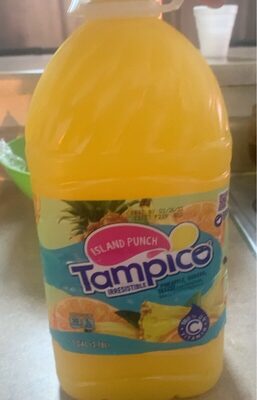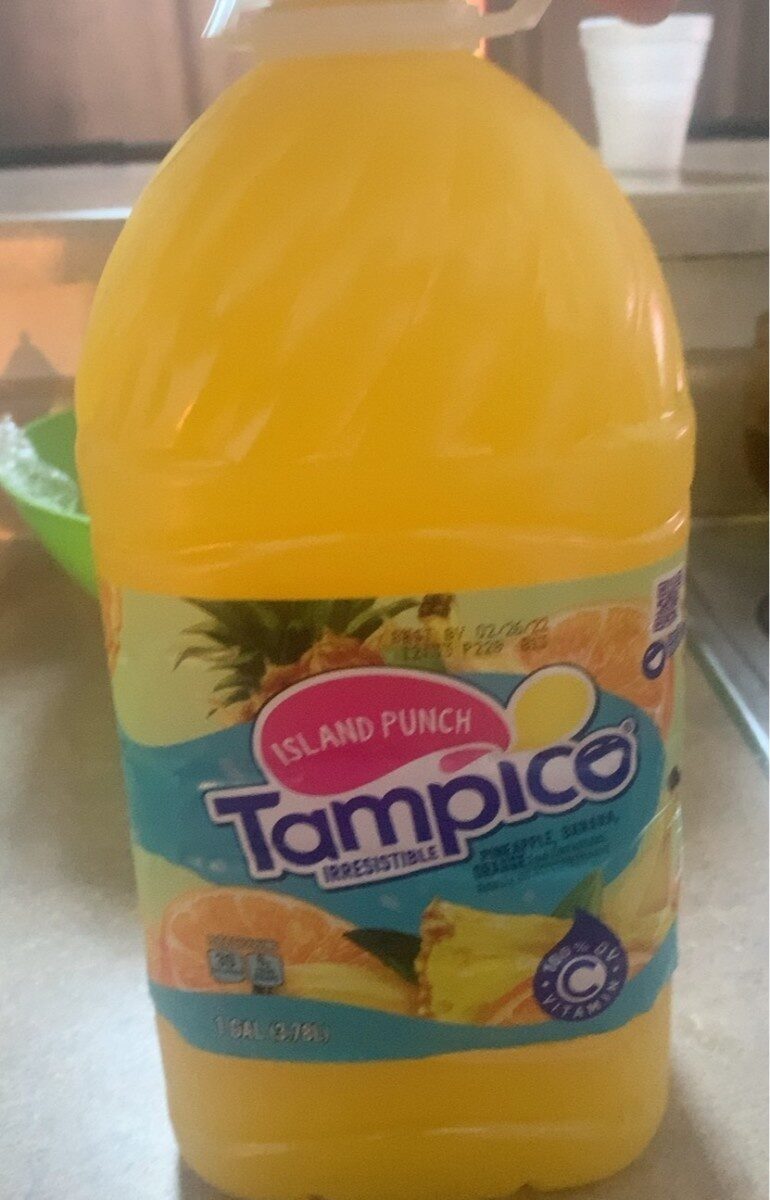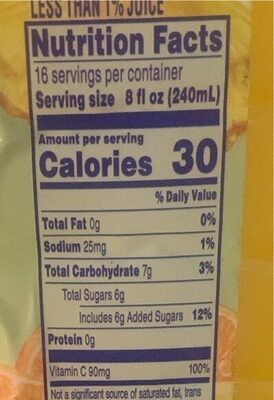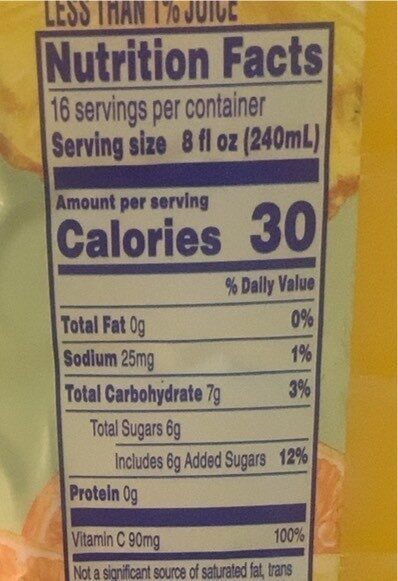Help us make food transparency the norm!
As a non-profit organization, we depend on your donations to continue informing consumers around the world about what they eat.
The food revolution starts with you!
Tampico Juice - 1 Gal (3.78 L)
Tampico Juice - 1 Gal (3.78 L)
This product page is not complete. You can help to complete it by editing it and adding more data from the photos we have, or by taking more photos using the app for Android or iPhone/iPad. Thank you!
×
Barcode: 0095188061295 (EAN / EAN-13) 095188061295 (UPC / UPC-A)
Common name: Pineapple-Banana-Orange Island Punch
Quantity: 1 Gal (3.78 L)
Packaging: Plastic Bottle
Brands: Tampico, Niagra Bottling LLC
Categories: Beverages, Juice drink
Origin of ingredients: United States
Manufacturing or processing places: United States
Countries where sold: United States
Matching with your preferences
Health
Ingredients
-
24 ingredients
WATER, HIGH FRUCTOSE CORN SYRUP, LESS THAN 2% OF PINEAPPLE JUICE FROM CONCENTRATE, BANANA JUICE FROM CONCENTRATE, ORANGE JUICE FROM CONCENTRATE, ASCORBIC ACID (VITAMIN C), NATURAL AND ARTIFICIAL FLAVORS, POTASSIUM SORBATE (PRESERVATIVE), EDTA (TO HELP PROTECT FLAVOR), SUCRALOSE, ACESULFAME POTASSIUM, NEOTAME, CITRIC ACID, MALIC ACID, POTASSIUM CITRATE, SODIUM CITRATE, FOOD STARCH - MODIFIED, YELLOW 5, YELLOW 6, CORN OIL, XANTHAN GUM.
Food processing
-
Ultra processed foods
Elements that indicate the product is in the 4 - Ultra processed food and drink products group:
- Additive: E102 - Tartrazine
- Additive: E110 - Sunset yellow FCF
- Additive: E415 - Xanthan gum
- Additive: E950 - Acesulfame k
- Additive: E955 - Sucralose
- Additive: E961 - Neotame
- Ingredient: Flavouring
- Ingredient: Glucose
- Ingredient: High fructose corn syrup
Food products are classified into 4 groups according to their degree of processing:
- Unprocessed or minimally processed foods
- Processed culinary ingredients
- Processed foods
- Ultra processed foods
The determination of the group is based on the category of the product and on the ingredients it contains.
Additives
-
E102 - Tartrazine
Tartrazine: Tartrazine is a synthetic lemon yellow azo dye primarily used as a food coloring. It is also known as E number E102, C.I. 19140, FD&C Yellow 5, Acid Yellow 23, Food Yellow 4, and trisodium 1--4-sulfonatophenyl--4--4-sulfonatophenylazo--5-pyrazolone-3-carboxylate-.Tartrazine is a commonly used color all over the world, mainly for yellow, and can also be used with Brilliant Blue FCF -FD&C Blue 1, E133- or Green S -E142- to produce various green shades.Source: Wikipedia
-
E110 - Sunset yellow FCF
Sunset Yellow FCF: Sunset Yellow FCF -also known as Orange Yellow S, or C.I. 15985- is a petroleum-derived orange azo dye with a pH dependent maximum absorption at about 480 nm at pH 1 and 443 nm at pH 13 with a shoulder at 500 nm. When added to foods sold in the US it is known as FD&C Yellow 6; when sold in Europe, it is denoted by E Number E110.Source: Wikipedia
-
E202 - Potassium sorbate
Potassium sorbate (E202) is a synthetic food preservative commonly used to extend the shelf life of various food products.
It works by inhibiting the growth of molds, yeast, and some bacteria, preventing spoilage. When added to foods, it helps maintain their freshness and quality.
Some studies have shown that when combined with nitrites, potassium sorbate have genotoxic activity in vitro. However, potassium sorbate is generally recognized as safe (GRAS) by regulatory authorities.
-
E296 - Malic acid
Malic acid: Malic acid is an organic compound with the molecular formula C4H6O5. It is a dicarboxylic acid that is made by all living organisms, contributes to the pleasantly sour taste of fruits, and is used as a food additive. Malic acid has two stereoisomeric forms -L- and D-enantiomers-, though only the L-isomer exists naturally. The salts and esters of malic acid are known as malates. The malate anion is an intermediate in the citric acid cycle.Source: Wikipedia
-
E330 - Citric acid
Citric acid is a natural organic acid found in citrus fruits such as lemons, oranges, and limes.
It is widely used in the food industry as a flavor enhancer, acidulant, and preservative due to its tart and refreshing taste.
Citric acid is safe for consumption when used in moderation and is considered a generally recognized as safe (GRAS) food additive by regulatory agencies worldwide.
-
E415 - Xanthan gum
Xanthan gum (E415) is a natural polysaccharide derived from fermented sugars, often used in the food industry as a thickening and stabilizing agent.
This versatile food additive enhances texture and prevents ingredient separation in a wide range of products, including salad dressings, sauces, and gluten-free baked goods.
It is considered safe for consumption even at high intake amounts.
-
E950 - Acesulfame k
Acesulfame potassium: Acesulfame potassium - AY-see-SUL-faym-, also known as acesulfame K -K is the symbol for potassium- or Ace K, is a calorie-free sugar substitute -artificial sweetener- often marketed under the trade names Sunett and Sweet One. In the European Union, it is known under the E number -additive code- E950. It was discovered accidentally in 1967 by German chemist Karl Clauss at Hoechst AG -now Nutrinova-. In chemical structure, acesulfame potassium is the potassium salt of 6-methyl-1‚2,3-oxathiazine-4-3H--one 2‚2-dioxide. It is a white crystalline powder with molecular formula C4H4KNO4S and a molecular weight of 201.24 g/mol.Source: Wikipedia
-
E955 - Sucralose
Sucralose: Sucralose is an artificial sweetener and sugar substitute. The majority of ingested sucralose is not broken down by the body, so it is noncaloric. In the European Union, it is also known under the E number E955. It is produced by chlorination of sucrose. Sucralose is about 320 to 1‚000 times sweeter than sucrose, three times as sweet as both aspartame and acesulfame potassium, and twice as sweet as sodium saccharin. Evidence of benefit is lacking for long-term weight loss with some data supporting weight gain and heart disease risks.It is stable under heat and over a broad range of pH conditions. Therefore, it can be used in baking or in products that require a long shelf life. The commercial success of sucralose-based products stems from its favorable comparison to other low-calorie sweeteners in terms of taste, stability, and safety. Common brand names of sucralose-based sweeteners are Splenda, Zerocal, Sukrana, SucraPlus, Candys, Cukren, and Nevella. Canderel Yellow also contains sucralose, but the original Canderel and Green Canderel do not.Source: Wikipedia
-
E961 - Neotame
Neotame: Neotame is an artificial sweetener made by NutraSweet that is between 7‚000 and 13‚000 times sweeter than sucrose -table sugar-. In the European Union, it is known by the E number E961. It is moderately heat-stable, extremely potent, rapidly metabolized, completely eliminated, and does not appear to accumulate in the body.The major metabolic pathway is hydrolysis of the methyl ester by esterases that are present throughout the body, which yields de-esterified neotame and methanol. Because only trace amounts of neotame are needed to sweeten foods, the amount of methanol derived from neotame is much lower than that found in common foods.The product is attractive to food manufacturers, as its use greatly lowers the cost of production compared to using sugar or high fructose corn syrup -due to the lower quantities needed to achieve the same sweetening-, while also benefitting the consumer by providing fewer "empty" sugar calories and a lower impact on blood sugar.Source: Wikipedia
Ingredients analysis
-
Palm oil free
No ingredients containing palm oil detected
Unrecognized ingredients: Less-than-2-of-pineapple-juice-from-concentrate, Edta, To-help-protect-flavorSome ingredients could not be recognized.
We need your help!
You can help us recognize more ingredients and better analyze the list of ingredients for this product and others:
- Edit this product page to correct spelling mistakes in the ingredients list, and/or to remove ingredients in other languages and sentences that are not related to the ingredients.
- Add new entries, synonyms or translations to our multilingual lists of ingredients, ingredient processing methods, and labels.
If you would like to help, join the #ingredients channel on our Slack discussion space and/or learn about ingredients analysis on our wiki. Thank you!
-
Vegan status unknown
Unrecognized ingredients: Less-than-2-of-pineapple-juice-from-concentrate, Vitamin C, Edta, To-help-protect-flavor, Sodium citrateSome ingredients could not be recognized.
We need your help!
You can help us recognize more ingredients and better analyze the list of ingredients for this product and others:
- Edit this product page to correct spelling mistakes in the ingredients list, and/or to remove ingredients in other languages and sentences that are not related to the ingredients.
- Add new entries, synonyms or translations to our multilingual lists of ingredients, ingredient processing methods, and labels.
If you would like to help, join the #ingredients channel on our Slack discussion space and/or learn about ingredients analysis on our wiki. Thank you!
-
Vegetarian status unknown
Unrecognized ingredients: Less-than-2-of-pineapple-juice-from-concentrate, Vitamin C, Edta, To-help-protect-flavor, Sodium citrateSome ingredients could not be recognized.
We need your help!
You can help us recognize more ingredients and better analyze the list of ingredients for this product and others:
- Edit this product page to correct spelling mistakes in the ingredients list, and/or to remove ingredients in other languages and sentences that are not related to the ingredients.
- Add new entries, synonyms or translations to our multilingual lists of ingredients, ingredient processing methods, and labels.
If you would like to help, join the #ingredients channel on our Slack discussion space and/or learn about ingredients analysis on our wiki. Thank you!
-
Details of the analysis of the ingredients
We need your help!
Some ingredients could not be recognized.
We need your help!
You can help us recognize more ingredients and better analyze the list of ingredients for this product and others:
- Edit this product page to correct spelling mistakes in the ingredients list, and/or to remove ingredients in other languages and sentences that are not related to the ingredients.
- Add new entries, synonyms or translations to our multilingual lists of ingredients, ingredient processing methods, and labels.
If you would like to help, join the #ingredients channel on our Slack discussion space and/or learn about ingredients analysis on our wiki. Thank you!
: WATER, HIGH FRUCTOSE CORN SYRUP, LESS THAN 2% OF PINEAPPLE JUICE FROM CONCENTRATE, BANANA, ORANGE JUICE FROM CONCENTRATE, ASCORBIC ACID (VITAMIN C), NATURAL and ARTIFICIAL FLAVORS, POTASSIUM SORBATE (PRESERVATIVE), EDTA (TO HELP PROTECT FLAVOR), SUCRALOSE, ACESULFAME POTASSIUM, NEOTAME, CITRIC ACID, MALIC ACID, POTASSIUM CITRATE, SODIUM CITRATE, FOOD STARCH-MODIFIED, YELLOW 5, YELLOW 6, CORN OIL, XANTHAN GUM- WATER -> en:water - vegan: yes - vegetarian: yes - ciqual_food_code: 18066 - percent_min: 4.76190476190476 - percent_max: 100
- HIGH FRUCTOSE CORN SYRUP -> en:high-fructose-corn-syrup - vegan: yes - vegetarian: yes - ciqual_food_code: 31077 - percent_min: 0 - percent_max: 50
- LESS THAN 2% OF PINEAPPLE JUICE FROM CONCENTRATE -> en:less-than-2-of-pineapple-juice-from-concentrate - percent_min: 0 - percent_max: 33.3333333333333
- BANANA -> en:banana - vegan: yes - vegetarian: yes - ciqual_food_code: 13005 - percent_min: 0 - percent_max: 25
- ORANGE JUICE FROM CONCENTRATE -> en:orange-juice-from-concentrate - vegan: yes - vegetarian: yes - ciqual_food_code: 2012 - percent_min: 0 - percent_max: 20
- ASCORBIC ACID -> en:e300 - vegan: yes - vegetarian: yes - percent_min: 0 - percent_max: 16.6666666666667
- VITAMIN C -> en:vitamin-c - percent_min: 0 - percent_max: 16.6666666666667
- NATURAL and ARTIFICIAL FLAVORS -> en:natural-and-artificial-flavouring - vegan: maybe - vegetarian: maybe - percent_min: 0 - percent_max: 5
- POTASSIUM SORBATE -> en:e202 - vegan: yes - vegetarian: yes - percent_min: 0 - percent_max: 5
- PRESERVATIVE -> en:preservative - percent_min: 0 - percent_max: 5
- EDTA -> en:edta - percent_min: 0 - percent_max: 5
- TO HELP PROTECT FLAVOR -> en:to-help-protect-flavor - percent_min: 0 - percent_max: 5
- SUCRALOSE -> en:e955 - vegan: yes - vegetarian: yes - percent_min: 0 - percent_max: 5
- ACESULFAME POTASSIUM -> en:e950 - vegan: yes - vegetarian: yes - percent_min: 0 - percent_max: 5
- NEOTAME -> en:e961 - vegan: yes - vegetarian: yes - percent_min: 0 - percent_max: 5
- CITRIC ACID -> en:e330 - vegan: yes - vegetarian: yes - percent_min: 0 - percent_max: 5
- MALIC ACID -> en:e296 - vegan: yes - vegetarian: yes - percent_min: 0 - percent_max: 5
- POTASSIUM CITRATE -> en:e332ii - vegan: yes - vegetarian: yes - percent_min: 0 - percent_max: 5
- SODIUM CITRATE -> en:sodium-citrate - percent_min: 0 - percent_max: 5
- FOOD STARCH-MODIFIED -> en:modified-starch - vegan: yes - vegetarian: yes - ciqual_proxy_food_code: 9510 - percent_min: 0 - percent_max: 5
- YELLOW 5 -> en:e102 - vegan: yes - vegetarian: yes - percent_min: 0 - percent_max: 5
- YELLOW 6 -> en:e110 - vegan: yes - vegetarian: yes - percent_min: 0 - percent_max: 5
- CORN OIL -> en:corn-oil - vegan: yes - vegetarian: yes - from_palm_oil: no - ciqual_food_code: 17190 - percent_min: 0 - percent_max: 5
- XANTHAN GUM -> en:e415 - vegan: yes - vegetarian: yes - percent_min: 0 - percent_max: 4.76190476190476
Nutrition
-
Average nutritional quality
⚠ ️Warning: the amount of fruits, vegetables and nuts is not specified on the label, it was estimated from the list of ingredients: 8This product is considered a beverage for the calculation of the Nutri-Score.
Positive points: 0
- Proteins: 0 / 5 (value: 0, rounded value: 0)
- Fiber: 0 / 5 (value: 0, rounded value: 0)
- Fruits, vegetables, nuts, and colza/walnut/olive oils: 0 / 10 (value: 8.92857142857142, rounded value: 8.9)
Negative points: 4
- Energy: 2 / 10 (value: 52, rounded value: 52)
- Sugars: 2 / 10 (value: 2.5, rounded value: 2.5)
- Saturated fat: 0 / 10 (value: 0, rounded value: 0)
- Sodium: 0 / 10 (value: 10.4166666666672, rounded value: 10.4)
The points for proteins are counted because the negative points are less than 11.
Nutritional score: (4 - 0)
Nutri-Score:
-
Nutrient levels
-
Fat in low quantity (0%)
What you need to know- A high consumption of fat, especially saturated fats, can raise cholesterol, which increases the risk of heart diseases.
Recommendation: Limit the consumption of fat and saturated fat- Choose products with lower fat and saturated fat content.
-
Saturated fat in low quantity (0%)
What you need to know- A high consumption of fat, especially saturated fats, can raise cholesterol, which increases the risk of heart diseases.
Recommendation: Limit the consumption of fat and saturated fat- Choose products with lower fat and saturated fat content.
-
Sugars in moderate quantity (2.5%)
What you need to know- A high consumption of sugar can cause weight gain and tooth decay. It also augments the risk of type 2 diabetes and cardio-vascular diseases.
Recommendation: Limit the consumption of sugar and sugary drinks- Sugary drinks (such as sodas, fruit beverages, and fruit juices and nectars) should be limited as much as possible (no more than 1 glass a day).
- Choose products with lower sugar content and reduce the consumption of products with added sugars.
-
Salt in low quantity (0.026%)
What you need to know- A high consumption of salt (or sodium) can cause raised blood pressure, which can increase the risk of heart disease and stroke.
- Many people who have high blood pressure do not know it, as there are often no symptoms.
- Most people consume too much salt (on average 9 to 12 grams per day), around twice the recommended maximum level of intake.
Recommendation: Limit the consumption of salt and salted food- Reduce the quantity of salt used when cooking, and don't salt again at the table.
- Limit the consumption of salty snacks and choose products with lower salt content.
-
-
Nutrition facts
Nutrition facts As sold
for 100 g / 100 mlAs sold
per serving (8 fl. oz (240 ml))Compared to: Beverages Energy 52 kj
(12 kcal)125 kj
(30 kcal)-76% Fat 0 g 0 g -100% Saturated fat 0 g 0 g -100% Carbohydrates 2.917 g 7 g -69% Sugars 2.5 g 6 g -65% Fiber 0 g 0 g -100% Proteins 0 g 0 g -100% Salt 0.026 g 0.062 g -52% Vitamin C (ascorbic acid) 60 mg 144 mg +268% Fruits‚ vegetables‚ nuts and rapeseed‚ walnut and olive oils (estimate from ingredients list analysis) 8.929 % 8.929 % -76%
Environment
-
Eco-Score not computed - Unknown environmental impact
We could not compute the Eco-Score of this product as it is missing some data, could you help complete it?Could you add a precise product category so that we can compute the Eco-Score? Add a category
Packaging
-
Packaging with a medium impact
-
Packaging parts
Bottle (Plastic)
-
Packaging materials
Material % Packaging weight Packaging weight per 100 g of product Plastic
-
Transportation
-
Origins of ingredients
Origins of ingredients with a medium impact
Origin of the product and/or its ingredients % of ingredients Impact United States 100 %Medium
Report a problem
-
Incomplete or incorrect information?
Category, labels, ingredients, allergens, nutritional information, photos etc.
If the information does not match the information on the packaging, please complete or correct it. Open Food Facts is a collaborative database, and every contribution is useful for all.
Data sources
Product added on by houstonfoodbank
Last edit of product page on by packbot.
Product page also edited by kiliweb, openfoodfacts-contributors, yuka.sY2b0xO6T85zoF3NwEKvlhVDQovhiDTkDjPttWyS-vmSEpHkWPVb46T3H6o.








